How to Optimize Your Local SEO to Rank for “Near Me” Searches

How to Rank for Local SEO “Near Me” Searches
“Near me” SEO (search engine optimization) searches have risen dramatically over the past decade. People are searching locally more and more for products and services.
Don’t believe us? The data shows different.
- 8 in 10 U.S. consumers search for local businesses weekly, while 32% do so daily.
- More than three-quarters of consumers who conduct a local search on their phone visit a business within 24 hours — 28% of those searches result in a purchase.
The data speaks for itself. Local businesses must appear in these relevant local search results on search engines like Google, Google Maps, or Apple Maps.
In this blog post, we’ll detail the following:
- The rise of “near me” searches in SEO over the last decade
- What influences “near me” searches and local SEO rankings
- How to improve your local search rankings
Let’s get started!
The 12-Year Rise of “Near Me” in SEO
Over the past decade, searches containing “near me” have risen dramatically. For now, “near me” searches hit their peak in July 2021, with an interest over time (IOT) score of 100 — the highest possible score on Google’s interest over time scale. Today, they remain relatively high, with an interest score of 59, which is high knowing near me is used millions of times monthly.
If you’re unfamiliar with it, an IOT score represents “search interest relative to the highest point on the chart for the given region and time.”
The graph below depicts the “near me” search term in the United States over the past 12 years.
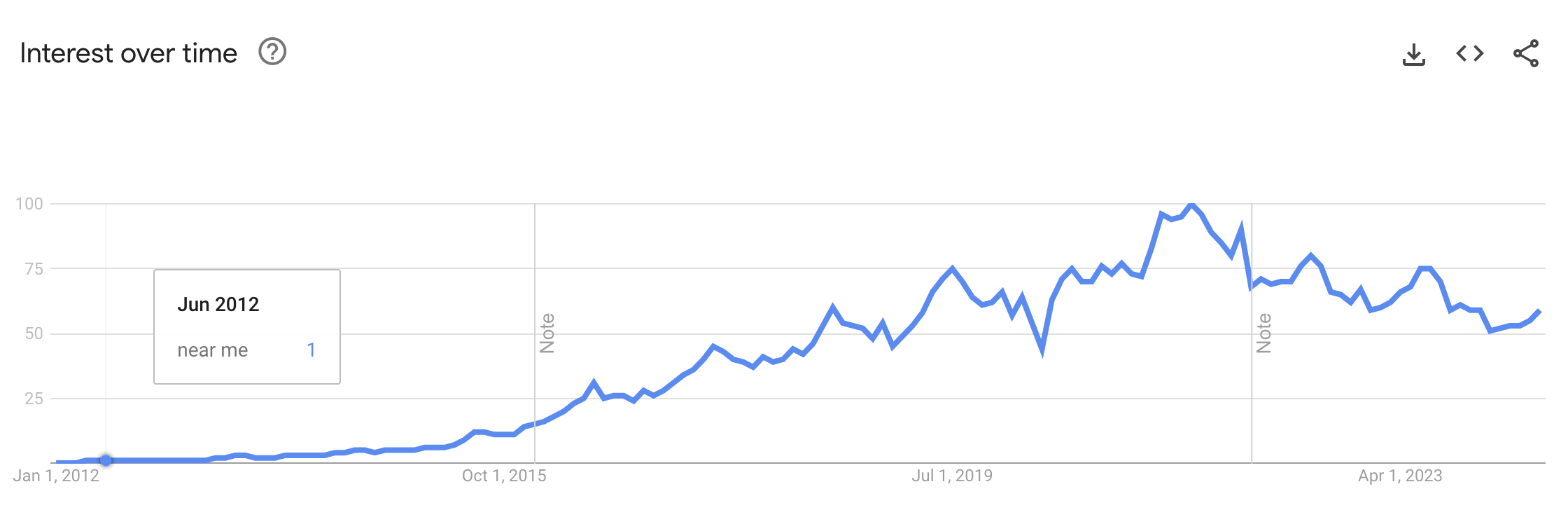
Smartphones Leading the Way
One likely driver of near me searches is smartphones’ popularity and expanding capabilities. From 2013 to 2018, “open” + “now” + “near me” mobile searches increased by more than 200%, and from 2015 to 2017, “near me” searches with “can I buy” or “to buy” increased by over 500%.

Top Related “Near Me” Queries
We know that people are searching locally for businesses, but what exactly are they wanting to find? Looking at Google Trends’ related queries to “near me” in 2024, these are the top 10 associated searches and their interest over time (IOT) score.
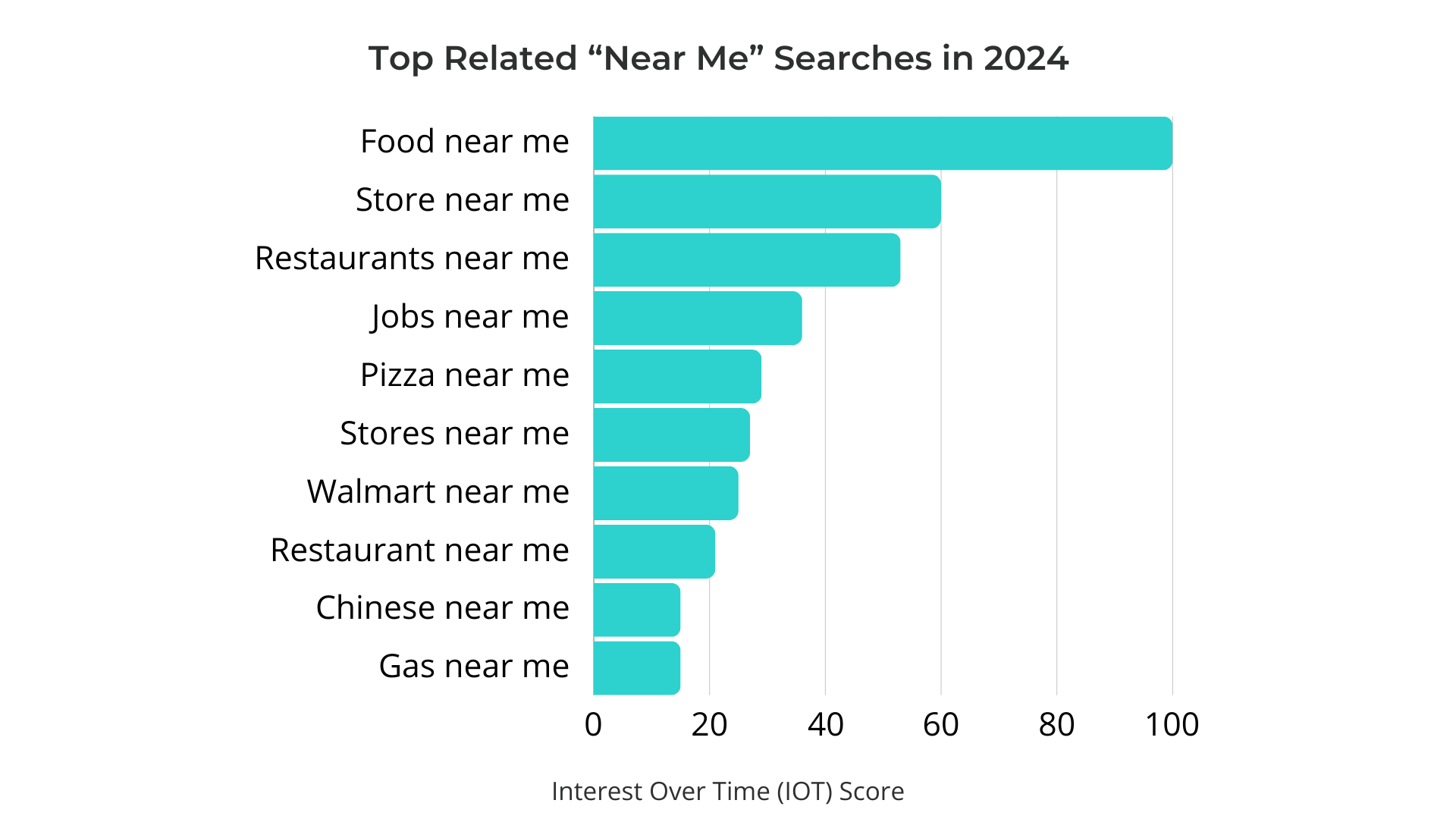
As you can see, food and restaurant queries dominate “near me” searches. However, people also search for stores, jobs, gas, and Walmarts near them at fairly significant rates.
Regardless of your industry, you must rank for local near me searches.
What Actually Impacts “Near Me” Searches in Local SEO?
Before we discuss how to improve your local search rankings, we must first explain a few “near me” SEO practices to avoid.
Gimmicky SEO Tricks That Don’t Work
A few small business owners thought putting “near me,” or similar queries in their name would improve their local SEO rankings. They did, for a bit, and then Google and other search engines penalized them. See an example below:
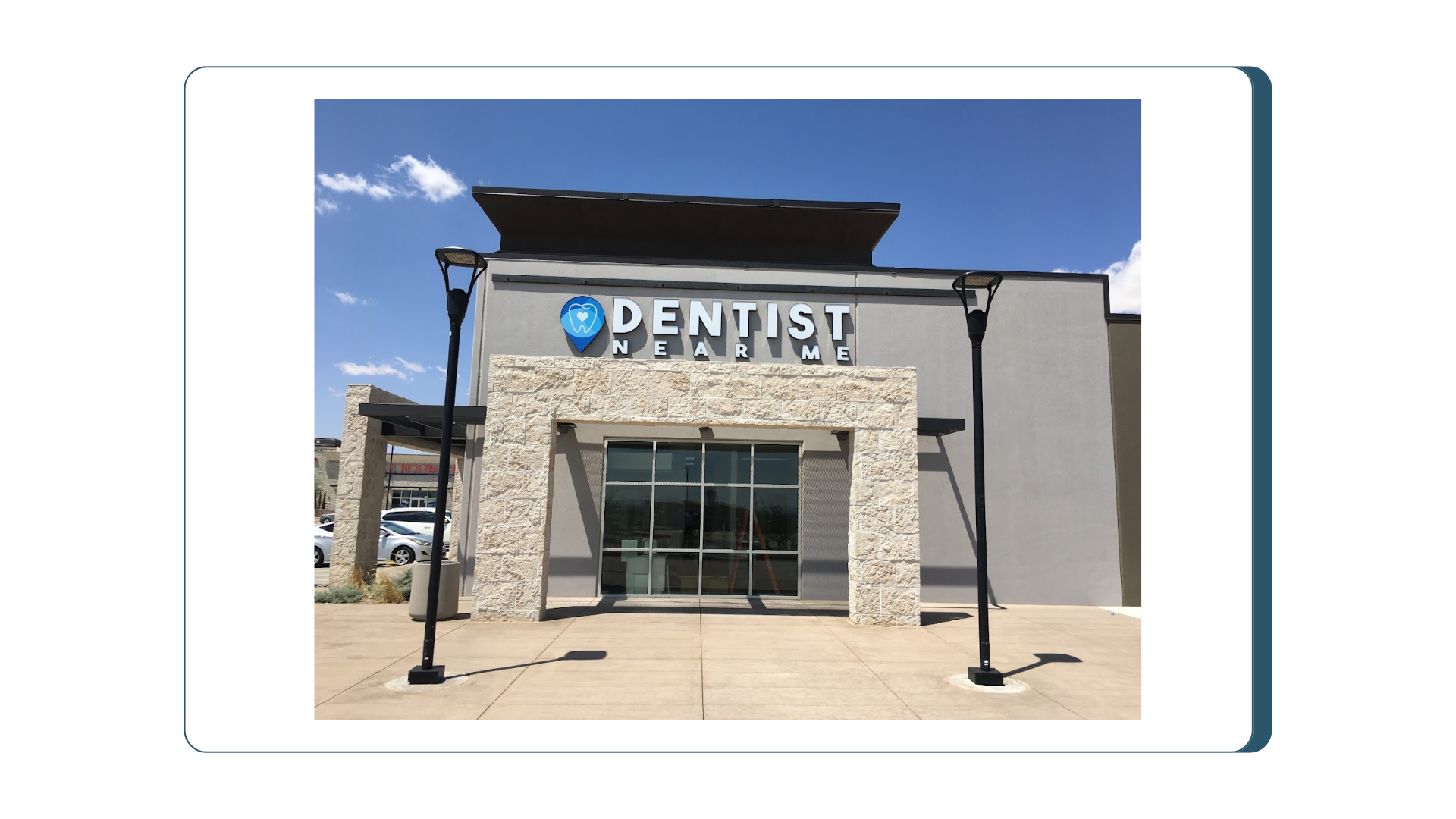
While this SEO tactic might have worked for a bit, Google’s November 2021 “Vicinity” update to local search focused on proximity in local search and combatting spammy keyword-rich business names.
Now, having “near me” in your business title does more harm than good.
Since consumers frequently search for information locally, it’s not as necessary to target geographically related keywords like “near me” or “open now.”
Google and other local search platforms do the work for you. Google has changed “near me” from a keyword-matching phrase to a proximity indicator. More on what this means below!
Relevance and Proximity’s Influence on Local Search Rankings
Google analyzes three main factors for local search queries: relevance, proximity, and prominence.
- Relevance: How well a local Google Business Profile matches what someone is searching for
- Proximity: Distance from the searcher’s current location
- Prominence: How well-known a business is and what information Google and users can find about a business across the web
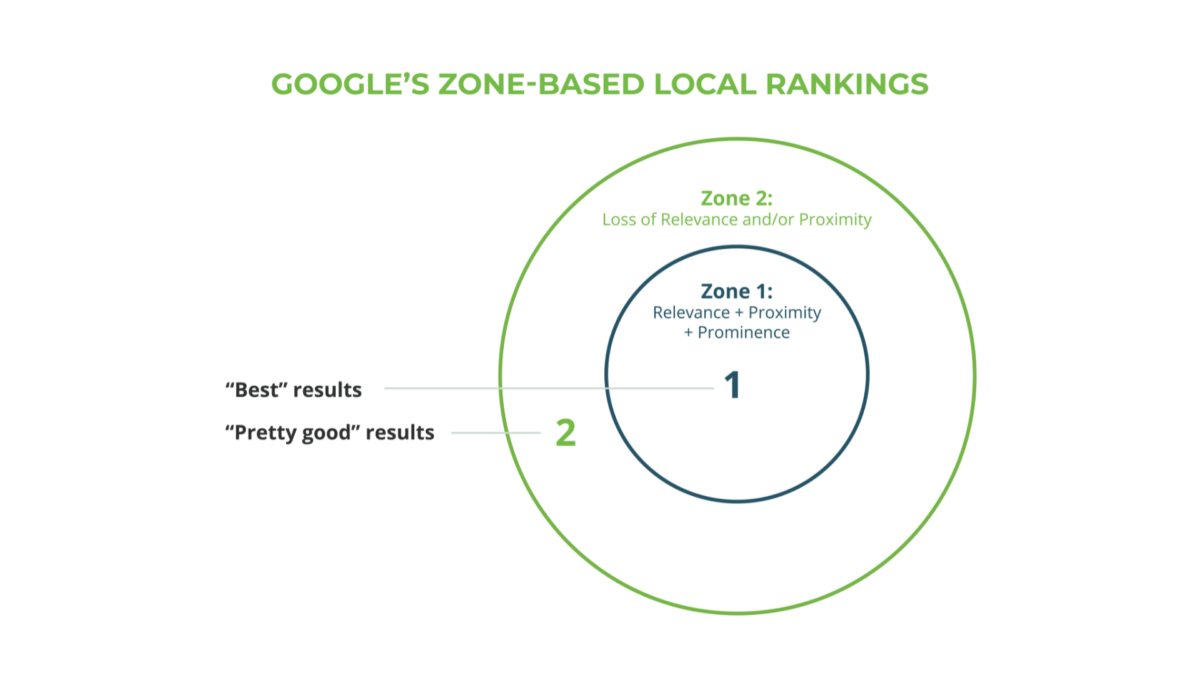
In general, businesses can influence relevance and prominence most by optimizing your Google Business Profile (GBP), website, and local landing pages for Google.
For insight into Google’s ranking factors and converting online users into customers, download our Top Ranking and Conversion Factors For Local Search report.
How to Improve Your Local Search and SEO to Rank for “Near Me”
You now know the importance of “near me” searches and how Google and other search engines rank your business in local search. Now, it’s time to learn how to improve your local search and SEO rankings.
Trust us; we’ve helped over 600 multi-location businesses improve their local search rankings.
1. Claim and Optimize Your Google Business Profiles
The most meaningful action you can take to appear in local search results is to claim your local listings, such as Google Profiles. When users search locally, Google typically displays a Google 3-pack, also known as the local pack.
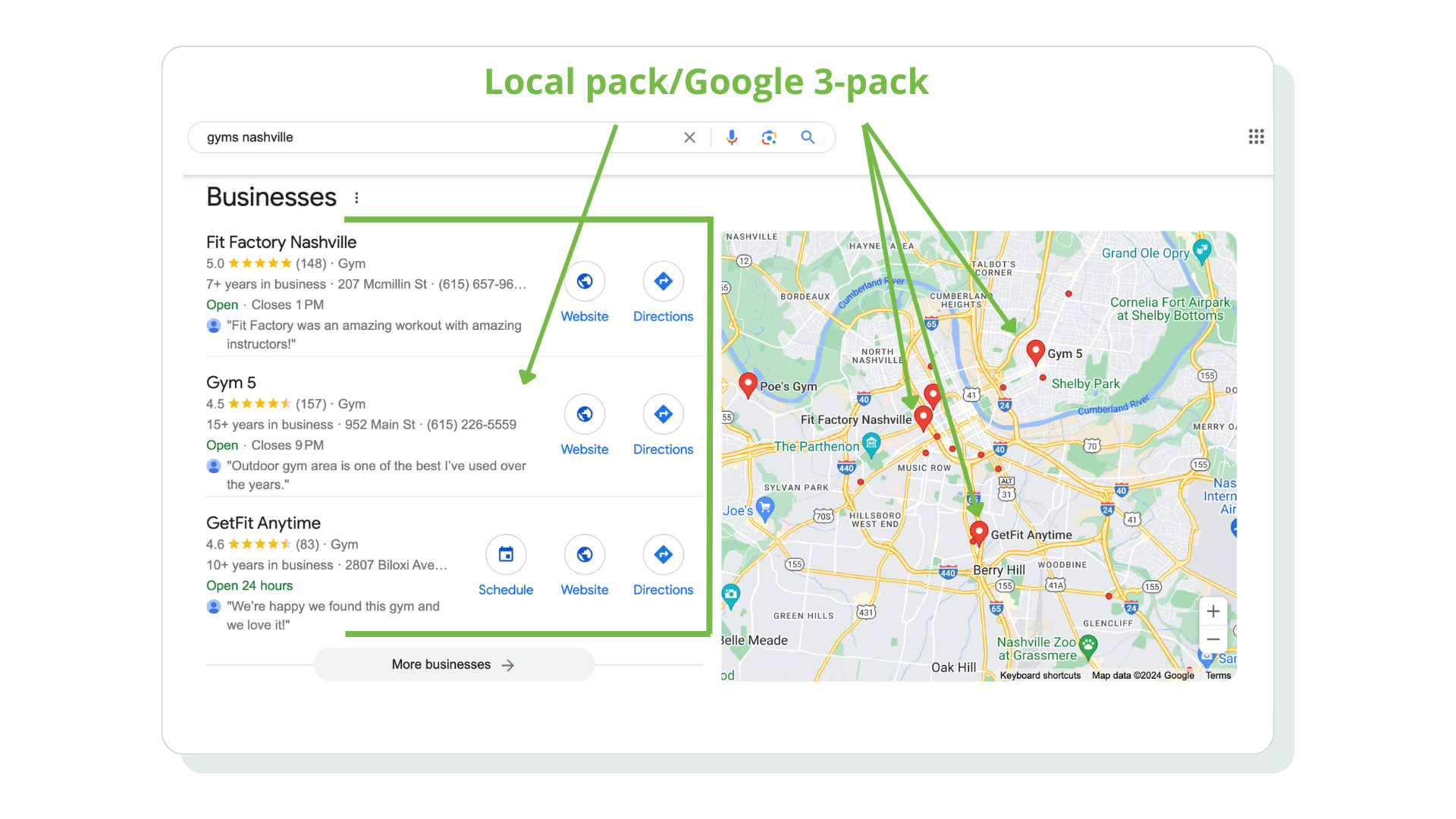
Our research found that businesses ranking in the 3-pack receive 126% more traffic and 93% more actions (calls, website clicks, and driving directions) than businesses ranked 4-10.
You cannot rank in the 3-pack without having a GBP for business locations. It’s also challenging to rank if the profile is not optimized.
To help rank in the 3-pack, you want to list business information people are most likely to be looking for, such as:
- Name, address, and phone number (NAP)
- Operating hours, especially during holidays or major events
- Products and services your business offers
- Online ratings and reviews
- A business category
- Select attributes
- High-quality photos and videos
- Relevant business information found in Google Posts
- Links to local landing pages and social media profiles
For more details, read our article on how to rank in the Google 3-Pack.
2. Create Local Landing Pages
Like business listings, you should also create local landing pages — often called local pages. Local landing pages are individual web pages for a specific business location. They’re particularly beneficial for multi-location brands.
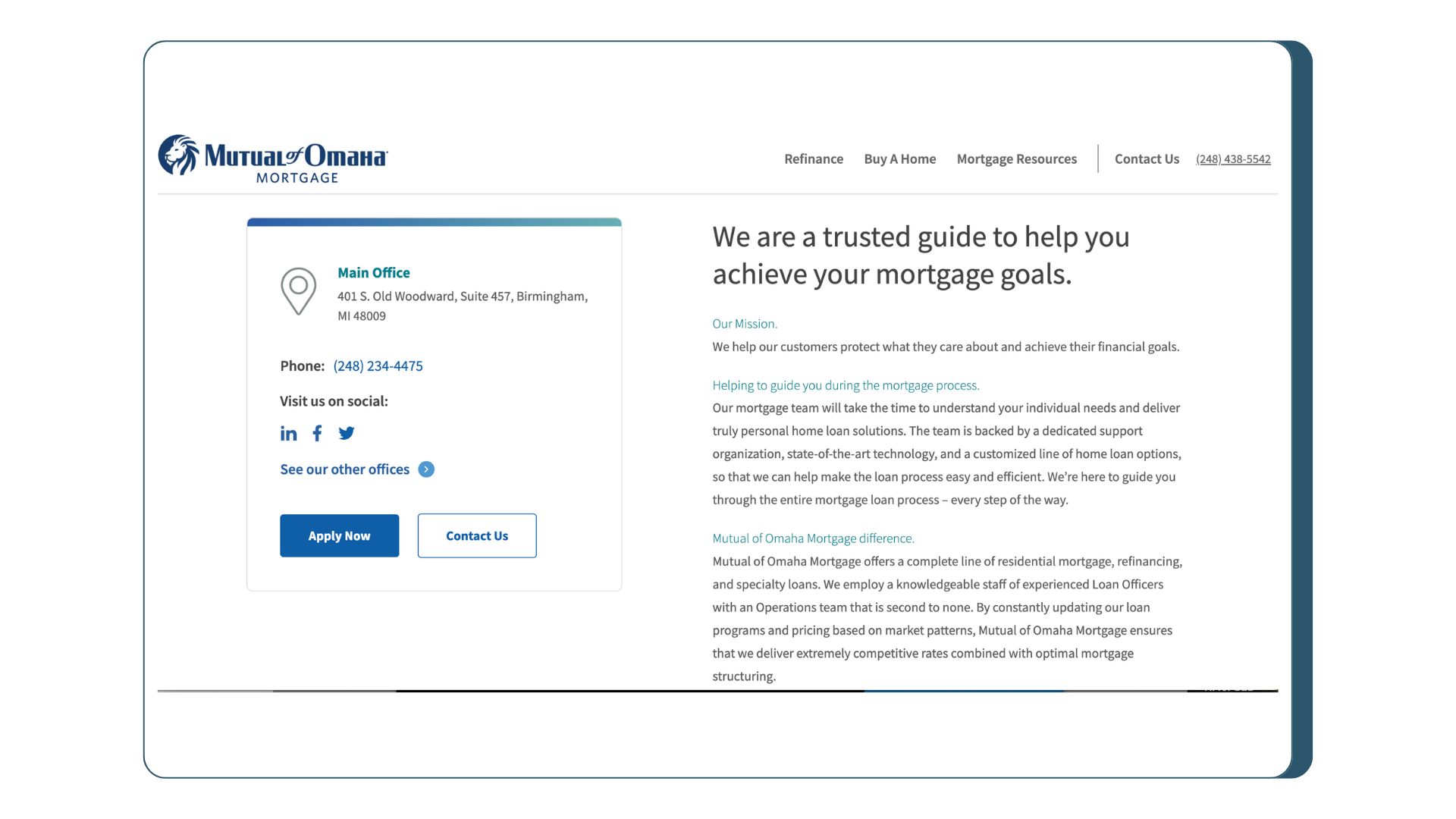
Like local listings, you need to optimize your local landing pages to help rank in relevant local searches. Here are a few tactics to optimize your local landing pages for search engines and consumers.
SEO tips:
- Incorporate keywords into your title
- Include high-quality photos and images
- Add alt text and tags to images
- Create SEO-optimized URLs with geographic-targeted keywords
- Standardize your name, address, and phone number (NAP) information
- Craft well-written and enticing meta descriptions
Consumer/User-experience (UX) tips:
- Be mobile-friendly
- List products, services, promos, and sales
- Highlight positive reviews and star ratings
- Embrace calls-to-action (CTAs)
- Include user-generated content (UGC)
Read our blog post on local landing pages for a complete guide on the benefits of local landing pages and how to optimize them best.
3. Acquire Reviews and Boost Your Online Reputation
Reviews and ratings, particularly positive reviews and high star ratings on your local listings, help your business rank better on search engines.
According to local SEO experts, “high numerical Google ratings (e.g., 4-5 stars)” is the sixth most important local pack/finder ranking factor, and “quantity of native Google reviews (w/ text)” is the eighth highest factor.
Our research further supports this correlation between review volume and rankings. We found that the top-ranking GBP average 404 reviews, while those ranked three through five average 281 reviews.
In addition to helping with local SEO or “near me” rankings, ratings and reviews help to convert consumers.
Our research report, The State of Google Reviews, found that for every 10 new reviews earned, Google profile conversions (conversion-oriented actions like phone calls, website clicks, and request for directions) improves by 2.8%.
Star ratings also matter. We found that conversion improves by 44% when a business increases its average star rating by one full star.
These findings reinforce the importance of obtaining positive reviews and ratings. It’s also worth noting that reviews with backlinks to your website’s local landing pages, resources, or blog content also help with SEO. More on that next!
To boost the number of positive ratings and reviews you receive, you need an online reputation management (ORM) strategy.
Download our Multi-Location Marketers Guide to Online Reputation Management to fully understand what ORM is and learn its best practices.
4. Update On-Page SEO
On-page SEO falls under both general and local SEO as it involves making your website, local landing pages, and listings search engine-friendly. If you’re unfamiliar, general SEO is the practice of enhancing a website’s visibility and ranking on the search engine results pages (SERP) through various techniques and strategies to attract organic traffic.
We shared some of these on-page SEO tactics earlier when discussing local landing pages and listings, but they’re worth doing across all owned web pages.
- Keywords: When it works, add keywords to your website, landing pages, and local listings in URLs, title tags, and meta descriptions.
- URL Structure: Try to include a primary keyword once in your URL structure, and place hyphens between words.
- Meta Description: Meta descriptions appear below title tags. They’re a 50-160 character hook that entices the reader and should include a keyword.
- Internal Links: Internal links are links from one page on your site to another internal or owned page. Incorporate internal links across your website, particularly between your main website and local landing pages.
- Alt Text: Add alt-text to all images you upload to your website or local listings. Alt text are descriptions of your photos. They allow visually impaired internet users and search engines to understand your images better.
5. Include Schema Markup
Schema markup, sometimes called structured data, is a form of communication to search engines to help them understand the meaning and context of your web pages.
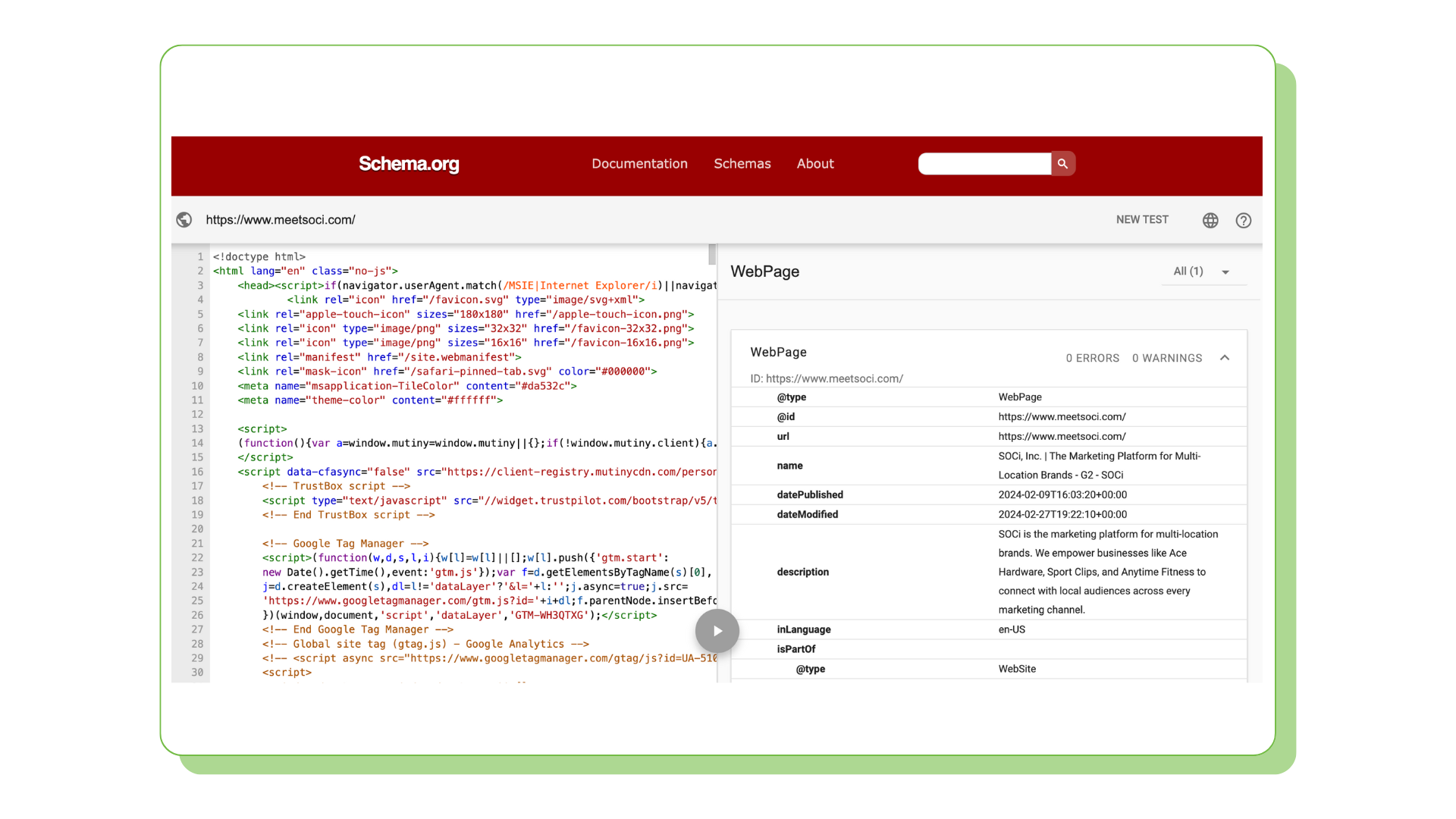
For instance, on your local landing page, your operating hours would need the schema markup “openingHours” to signify to search engines your hours each day of the week.
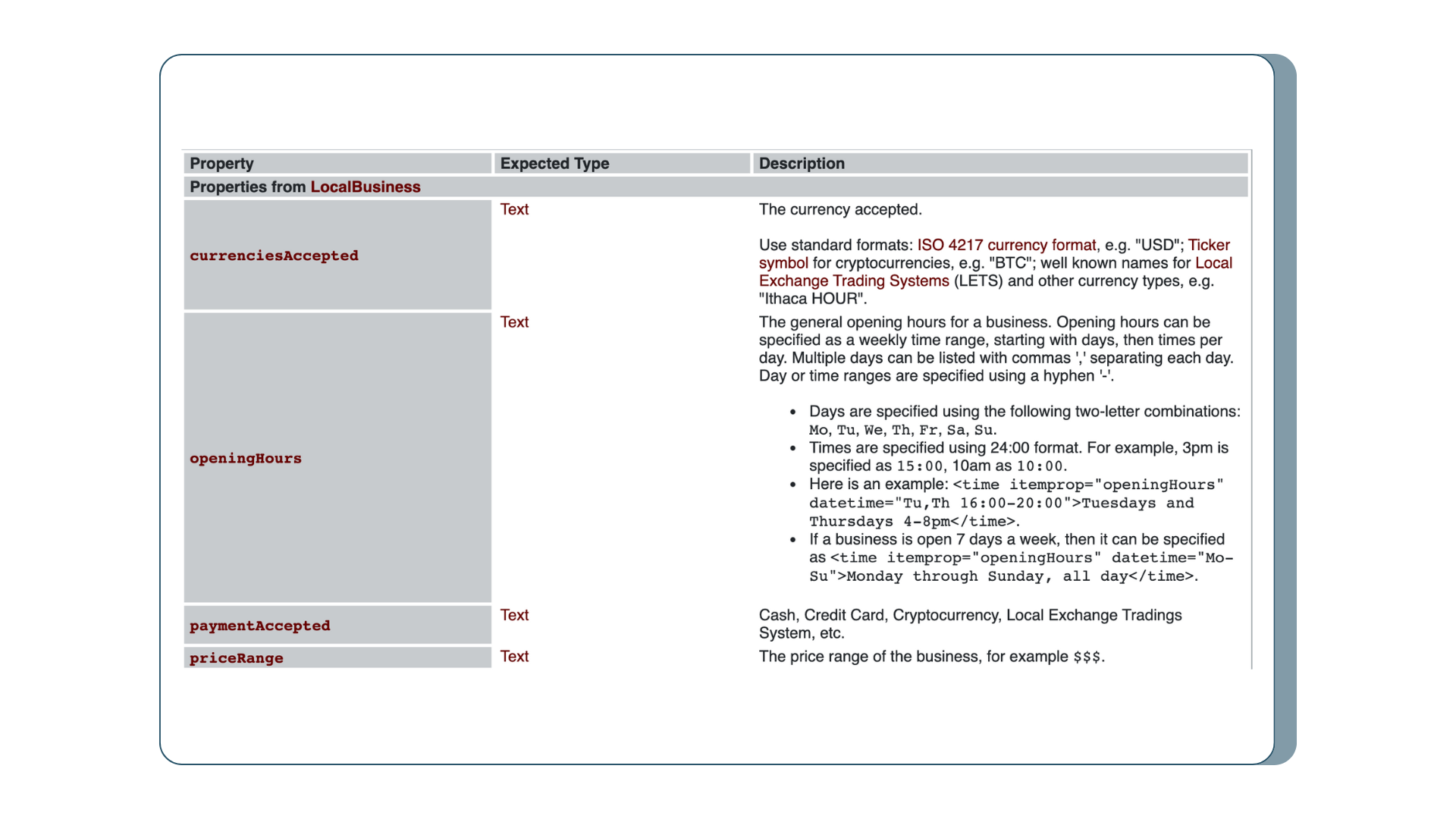
Schema markup not only enhances the visibility of your business in search engine results but also improves your chance to rank for “near me” searches. For example, when a user searches for “bakery near me,” search engines can pull the structured data from your schema markup to deliver more relevant and accurate results.
Visit Schema.org to find detailed documentation and tutorials for implementing schema markup on your website.
6. Gain Backlinks
Backlinks are links or citations coming from other websites to yours. Depending on the type, backlinks can both hurt or help your local SEO.
Backlinks from spammy sites or link farms are harmful, while backlinks from reputable and high-quality sites can increase your website and brand’s authority in a space. Here’s a breakdown of positive and negative backlinks:
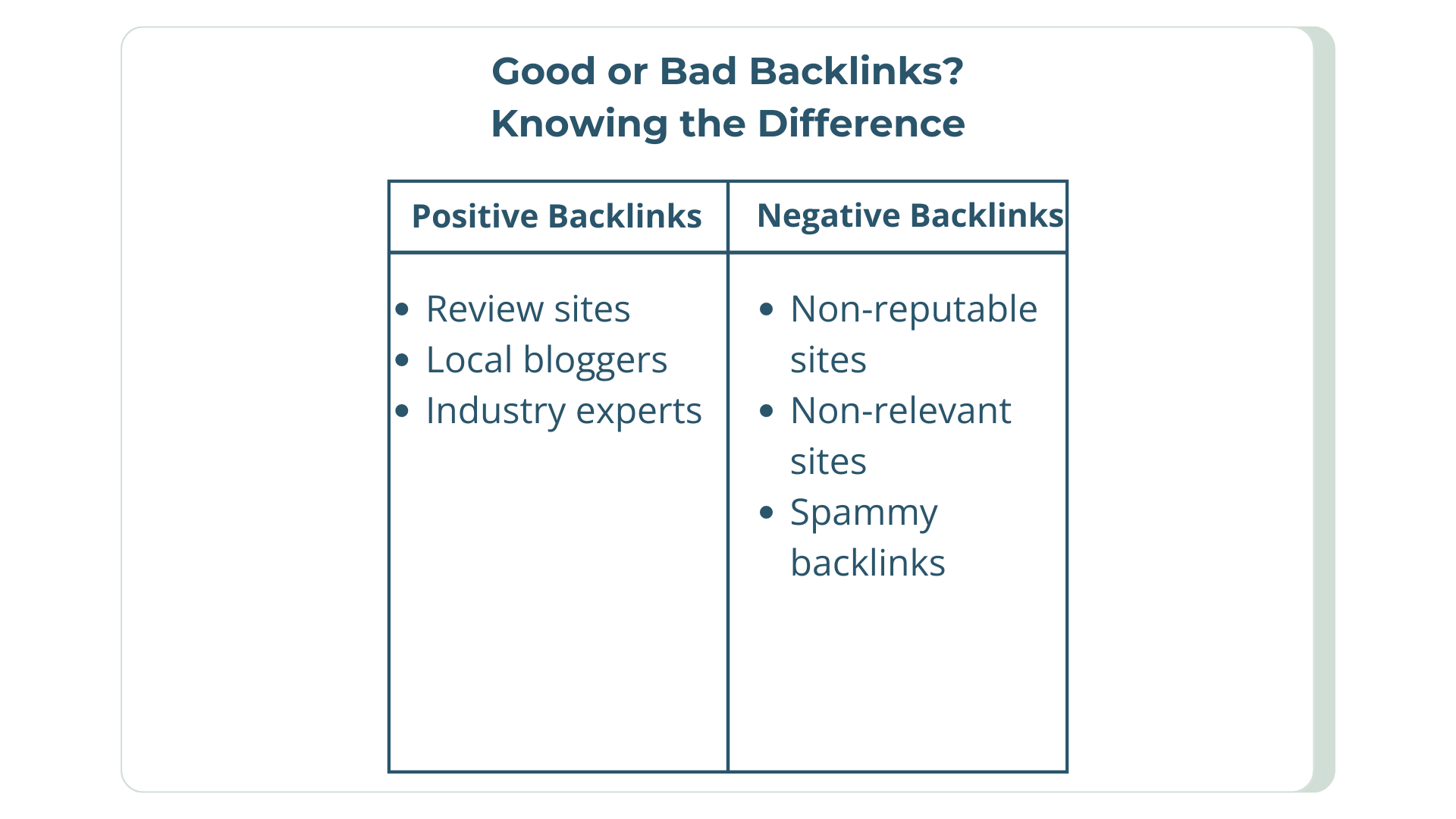
For more information on backlinks and how they affect SEO, read our blog on conducting a local SEO audit. Here are a few tactics to help you gain backlinks:
- Elevate your PR efforts, especially with local journalists and bloggers
- Create proprietary content such as data studies, surveys, and research reports
- Consider guest posts or guest posting for other sites and blogs
Lastly, assess the anchor text you receive from PR or guest posting efforts. You should aim for geographically rich anchor text. For instance, if you’re a gym in Brooklyn, New York, you want anchor texts such as “Brooklyn gym,” “gym in Brooklyn,” “fitness Brooklyn,” or “21st street gym.”
For more detailed information on how to rank on local SEO and for “near me” searches, download our Top 10 Things You Should Be Doing in Local SEO guide.
Using the Right Tools to Improve Local or “Near Me” SEO
We mentioned earlier that you must create and optimize your local listings and landing pages to rank in local search. You must also acquire positive reviews and ratings, gain backlinks, and update your on-page SEO.
These tasks take time and energy, especially if you’re a multi-location marketer with 100s or 1,000s of locations to manage. SOCi can make things easier!
SOCi is the CoMarketing Cloud for multi-location enterprises. Our AI solution, Genius Search is an AI-powered local search optimization tool.
Genius Search analyzes real-time data from multiple sources to enhance your local listings, leading to an increase in your business’s visibility in search engine results. It also ensures your listings are always current, aligns with consumer trends, and provides proactive, tailored recommendations for capitalizing on local search opportunities.
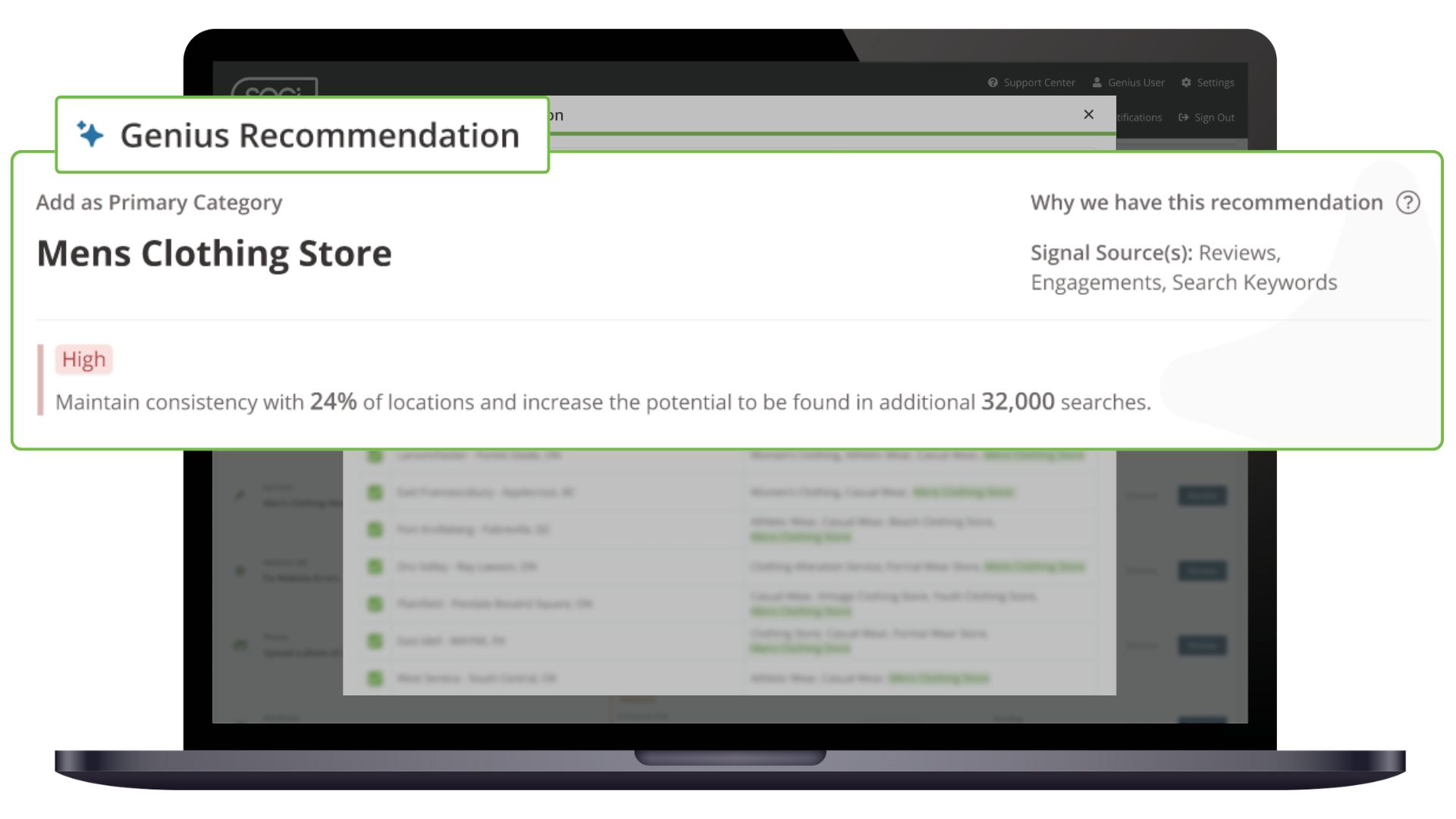
Furthermore, Genius Reviews uses AI to help monitor and respond to online reviews with an authentic, on-brand voice. This enhances your local stores’ online reputation, local search rankings, and boosts customer satisfaction and retention.
To learn more about how SOCi can help you rank in local SEO or for “near me” searches, request a demo today!








